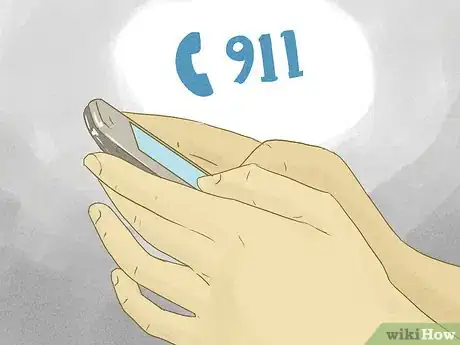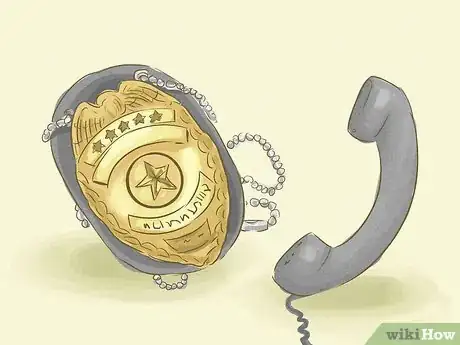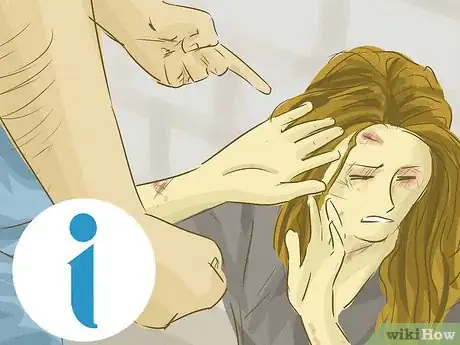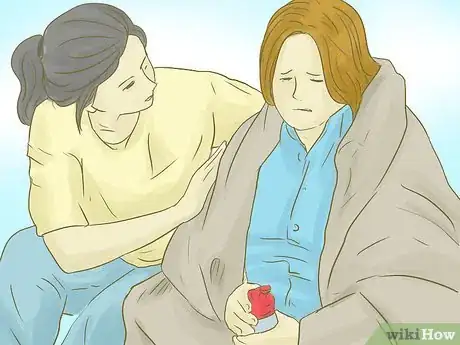X
This article was co-authored by wikiHow Staff. Our trained team of editors and researchers validate articles for accuracy and comprehensiveness. wikiHow's Content Management Team carefully monitors the work from our editorial staff to ensure that each article is backed by trusted research and meets our high quality standards.
This article has been viewed 28,268 times.
Learn more...
Elderly abuse is a widespread problem, so if you suspect someone you know is being abused, it's important that you report it. In California, you can call the police department, Adult Protective Services, and the Long-Term Care Ombudsman to report abuse. If you work with the elderly, it's also important to learn the signs of abuse.
Steps
Method 1
Method 1 of 2:
Dealing with the Immediate Issue
-
1Call 911. The first step to helping an elderly person is to get them the medical they need. If the person is malnourished, dehydrated, or incoherent, for instance, call emergency services so that the hospital can assess the elderly person.[1]
-
2Talk to the police. If you don't need to call 911 right away, it's still a good idea to make a report with the police. Call your local non-emergency number to report the abuse. You can ask if they have an elderly abuse unit, as many police departments do. The police will likely come out and check on the situation, as elderly abuse is a crime.Advertisement
-
3Find the Adult Protective Services (APS) number for your county. Elderly abuse is generally reported by county, so you'll need to find the appropriate number for APS in your county.[2]
-
4Report long-term care facilities to the Long-Term Care Ombudsman. When reporting a long-term care facility, you also need to make an additional call to the Ombudsman, who investigates claims of abuse in facilities. The crisis number is (800) 231-4024, and it is open 24 hours.[3]
- You can also find a local number at this website: https://www.aging.ca.gov/programs/ltcop/Contacts/
-
5Contact the appropriate department for specific facilities. For state mental hospitals and state developmental centers, you need to contact that state department. These departments have jurisdiction over investigations within these facilities.
- Contact the California Department of State Hospitals at (916) 654-2327 for mental hospitals. This number is for human rights. For other numbers, visit http://www.dsh.ca.gov/About_Us/Contact_Us.aspx.
- Call the California Department of Developmental Services for developmental centers at (916) 654-1690, which is their general number. You can find other contact information at http://www.dds.ca.gov/Contacts/Home.cfm.
-
6Know who is responsible for reporting. You must report abuse if you are a clergy member, a medical professional, or a professional caretaker. You also must report abuse if you are responsible for the care of an elderly person outside of professional care, such as if you are caring for a loved one.[4]
- If you fall in these categories and you don't report abuse, you can be convicted of a crime.
Advertisement
Method 2
Method 2 of 2:
Recognizing Abuse
-
1Look for signs of physical abuse. Physical abuse includes physical or sexual assault. It also includes physical restraint without cause. Withholding of food or water also falls into this category. While accidents do happen, reoccurring injuries can be a sign of abuse.[5]
- Physical evidence of abuse can include things like bruises, burns, or other injuries that do not have a good explanation.
-
2Check for signs of neglect. While neglect may not leave the person with bruises, the effects can be just as devastating. Neglect includes not giving the person appropriate food, water, and shelter, as well as not helping with hygiene or medical needs. Neglect can also mean not protecting the person from danger.[6]
- Signs of neglect include poor hygiene, dirty clothes, a matted scalp, undernourishment, dehydration, and uncontrolled medical conditions.
-
3Notice signs of emotional abuse. Emotional abuse is when the person is under emotional duress because of things the caregiver is doing. It can be threats, intimidation, cursing, or even not providing appropriate emotional support. Isolation is also a form of emotional abuse.[7]
- Signs of emotional abuse include the person withdrawing, appearing frightened, becoming depressed, or not wanting to talk about their condition.
-
4Pay attention to financial abuse. Another form of abuse is connected to finances. Many people take advantage of the elderly, as they are often not cognizant enough to realize what is happening.[8]
- Signs of financial abuse include a drain on the person's accounts, items going missing around the house, signatures on checks that don't match the person's signature, and signed checks when the person isn't capable of signing a check.
- In general, you have to be somewhat aware of the person's finances to recognize warning signs. However, you may also notice the person doesn't have things they need, such as basic care items. Also, a new person may have befriended the senior and offered to take over their finances.
Advertisement
References
- ↑ https://blog.ioaging.org/abuse-neglect-exploitation/reporting-elder-abuse-california-suspect-mistreatment-neglect/
- ↑ https://blog.ioaging.org/abuse-neglect-exploitation/reporting-elder-abuse-california-suspect-mistreatment-neglect/
- ↑ https://blog.ioaging.org/abuse-neglect-exploitation/reporting-elder-abuse-california-suspect-mistreatment-neglect/
- ↑ https://oag.ca.gov/sites/all/files/agweb/pdfs/bmfea/citizens_guide.pdf
- ↑ https://oag.ca.gov/sites/all/files/agweb/pdfs/bmfea/citizens_guide.pdf
- ↑ https://oag.ca.gov/sites/all/files/agweb/pdfs/bmfea/citizens_guide.pdf
- ↑ https://oag.ca.gov/sites/all/files/agweb/pdfs/bmfea/citizens_guide.pdf
- ↑ https://blog.ioaging.org/abuse-neglect-exploitation/reporting-elder-abuse-california-suspect-mistreatment-neglect/
About This Article
Advertisement





































































